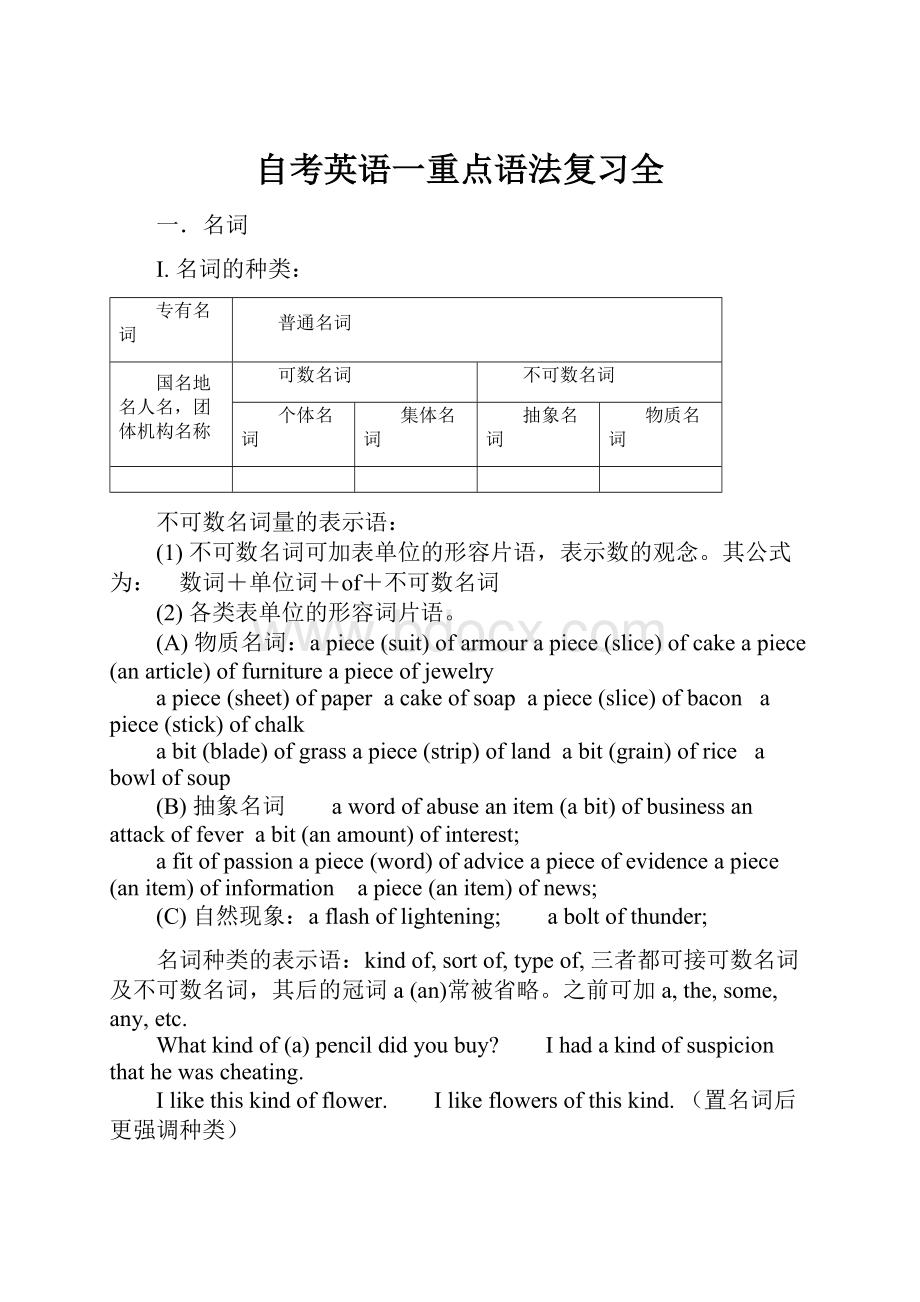自考英语一重点语法复习全.docx
《自考英语一重点语法复习全.docx》由会员分享,可在线阅读,更多相关《自考英语一重点语法复习全.docx(215页珍藏版)》请在冰豆网上搜索。

自考英语一重点语法复习全
一.名词
I.名词的种类:
专有名词
普通名词
国名地名人名,团体机构名称
可数名词
不可数名词
个体名词
集体名词
抽象名词
物质名词
不可数名词量的表示语:
(1)不可数名词可加表单位的形容片语,表示数的观念。
其公式为:
数词+单位词+of+不可数名词
(2)各类表单位的形容词片语。
(A)物质名词:
apiece(suit)ofarmourapiece(slice)ofcakeapiece(anarticle)offurnitureapieceofjewelry
apiece(sheet)ofpaperacakeofsoapapiece(slice)ofbaconapiece(stick)ofchalk
abit(blade)ofgrassapiece(strip)oflandabit(grain)ofriceabowlofsoup
(B)抽象名词 awordofabuseanitem(abit)ofbusinessanattackoffeverabit(anamount)ofinterest;
afitofpassionapiece(word)ofadviceapieceofevidenceapiece(anitem)ofinformation apiece(anitem)ofnews;
(C)自然现象:
aflashoflightening; aboltofthunder;
名词种类的表示语:
kindof,sortof,typeof,三者都可接可数名词及不可数名词,其后的冠词a(an)常被省略。
之前可加a,the,some,any,etc.
Whatkindof(a)pencildidyoubuy?
Ihadakindofsuspicionthathewascheating.
Ilikethiskindofflower. Ilikeflowersofthiskind.(置名词后更强调种类)
II.名词的数:
1.规则名词的复数形式:
名词的复数形式,一般在单数形式后面加-s或-es。
现将构成方法和读音规则列表如下:
规则
例词
1
一般情况在词尾加-s
map-maps,sea-seas,girl-girls,day-days
2
以s,x,ch,sh结尾的名词后加-es
class-classes,box-boxes,watch-watches,dish-dishes
3
以-f或-fe结尾的词
变-f和-fe为v再加-es
leaf-leaves,thief-thieves,knife-knives,wife-wives,half-halves
加-s
chief-chiefs,proof-proofs,roof-roofs
4
以辅音字母加y结尾的名词,变y为i加-es
party-parties,family-families,story-stories,city-cities
5
以元音字母加y结尾的名词,或专有名词以y结尾的,加-s
toy-toys,boy-boys,day-days,ray-rays,Henry-Henrys
6
以辅音字母加-o结尾的名词
一般加-es
Negro-Negroes,hero-heroes,potato-potatoes,tomato-tomatoes
不少外来词加-s
piano-pianos,photo-photos,auto-autos,kilo-kilos,solo-solos
两者皆可
zero-zeros/zeroes,volcano-volcanoes/volcanos
7
以元音字母加-o结尾的名词加-s
radio-radios,bamboo-bamboos,zoo-zoos
8
特殊变化
mediummedia,childchildren,
2.不规则名词复数:
英语里有些名词的复数形式是不规则的,现归纳如下:
规则
例词
1
改变名词中的元音字母或其他形式
man-men,woman-women,foot-feet,goose-geese,mouse-mice
2
单复数相同
sheep,deer,means,works,fish,yuan,jin,
3
只有复数形式
trousers,clothes,thanks,goods,glasses,
4
一些集体名词总是用作复数
people,police
5
部分集体名词既可以作单数(整体)也可以作复数(成员)
class,family,crowd,couple,group,government,population,team,public,party
6
复数形式表示特别含义
customs(海关),times(时代),spirits(情绪),drinks(饮料),sands(沙滩),papers(文件报纸),looks(外表),brains(头脑智力),greens(青菜)
7
表示“某国人”
加-s
Americans,Australians,Germans,Greeks,Swedes,Europeans
单复数同形
Swiss,Portuguese,Chinese,Japanese
以-man或-woman结尾的改为-men,-women
Englishmen,Frenchwomen
8
合成名词
将主体名词变为复数
sons-in-law,lookers-on,passers-by,story-tellers,boyfriends
无主体名词时将最后一部分变为复数
grown-ups,housewives,stopwatches
将两部分变为复数
womensingers,menservants
III.名词的所有格:
名词在句中表示所有关系的语法形式叫做名词所有格。
所有格分两种:
一是名词词尾加’s构成,二是由介词of加名词构成。
前者多表示有生命的东西,后者多表示无生命的东西。
1.’s所有格的构成:
单数名词在末尾加’s
theboy’sfather,Jack’sbook,herson-in-law’sphoto,
复数名词
一般在末尾加’
theteachers’room,thetwins’mother,
不规则复数名词后加’s
thechildren’stoys,women’srights,
以s结尾的人名所有格加’s或者’
Dickens’novels,Charles’sjob,theSmiths’house
表示各自的所有关系时,各名词末尾均须加’s
Japan’sandAmerica’sproblems,Jane’sandMary’sbikes
表示共有的所有关系时在最后一词末加’s
JapanandAmerica’sproblems,JaneandMary’sfather
表示"某人家""店铺",所有格后名词省略
thedoctor’s,thebarber’s,thetailor’s,myuncle’s
2.’s所有格的用法:
1
表示时间
today’snewspaper,fiveweeks’holiday
2
表示自然现象
theearth’satmosphere,thetree’sbranches
3
表示国家城市等地方的名词
thecountry’splan,theworld’spopulation,China’sindustry
4
表示工作群体
theship’screw,majority’sview,theteam’svictory
5
表示度量衡及价值
amile’sjourney,fivedollars’worthofapples
6
和人类活动有特殊关系的名词
thelife’stime,theplay’splot
7
某些固定词组
abird’seyeview,astone’sthrow,atone’swit’send(不知所措)
3.of所有格的用法:
用于无生命的东西:
thelegsofthechair,thecoverofthebook
用于有生命的东西,尤其是有较长定语时:
theclassroomsofthefirst-yearstudents
用于名词化的词:
thestruggleoftheoppressed
二.冠词
冠词分为不定冠词(a,an),定冠词(the),和零冠词。
I.不定冠词的用法:
1
指一类人或事,相当于akindof
Aplaneisamachinethatcanfly.
2
第一次提及某人某物,非特指
Aboyiswaitingforyou.
3
表示“每一”相当于every,one,per
Westudyeighthoursaday.
4
表示“相同”相当于thesame
Wearenearlyofanage.
5
用于人名前,表示不认识此人或和某名人有类似性质的人或事
AMr.Smithcametovisityouwhenyouwereout
ThatboyisratheraLeiFeng.
6
用于固定词组中
Acoupleof,abit,onceuponatime,inahurry,haveawalk,manyatime
7
用于quite,rather,many,half,what,such之后
Thisroomisratherabigone.
8
用于so(as,too,how)+形容词之后
Sheisascleveragirlasyoucanwishtomeet.
9
物质名词或抽象名词加a(an)即成普通名词
Thisisagoodclothforsummer.
10
“have(ortake)+a+抽象名词”,和抽象名词的动词形同义
Letustakeaswim.=Letusswim.
II.定冠词的用法:
1
表示某一类人或物
Thehorseisausefulanimal.
2
用于世上独一无二的事物名词前
theuniverse,themoon,thePacificOcean
3
表示说话双方都了解的或上文提到过的人或事
Wouldyoumindopeningthedoor?
4
用于乐器前面
playtheviolin,playtheguitar
5
用于形容词和分词前表示一类人
thereach,theliving,thewounded
6
表示“一家人”或“夫妇”
theGreens,theWangs
7
用于序数词和形容词副词比较级最高级前
Heisthetallerofthetwochildren.
8
用于专有名词前:
国家党派、公共建筑、机关、江河湖海、山川群岛、报刊、经典的名词前
theUnitedStates,theCommunistPartyofChina,theFrench
9
用于表示发明物的单数名词前
ThecompasswasinventedinChina.
10
在逢十的复数数词之前,指世纪的某个年代
inthe1990’s
11
用于表示单位的名词前
Ihiredthecarbythehour.
12
用于方位名词,身体部位名词,及表示时间的词组前
Hepattedmeontheshoulder.
13
用于为片语或子句所修饰的名词之前
ThisisthebookthatIpromisedtolendyou.
III.零冠词的用法:
1
专有名词,物质名词,抽象名词,人名地名等名词前
BeijingUniversity,Jack,China,love,air
2
名词前有this,my,whose,some,no,each,every等限制
Iwantthisbook,notthatone./Whosepurseisthis?
3
季节,月份,星期,节假日,一日三餐前
March,Sunday,NationalDay,spring
4
表示职位,身份,头衔的名词前
LincolnwasmadePresidentofAmerica.
5
学科,语言,球类,棋类,颜色名词前
Helikesplayingfootball/chess.
6
和by连用表示交通工具的名词前
bytrain,byair,byland
7
两个相对的名词并用时
husbandandwife,knifeandfork,daybyday,mantoman
8
表示泛指的复数名词前
Horsesareusefulanimals.
9
表官职、身份或亲属关系的名词当补语,或作同位语时不加冠词。
Hewaselectedpresident.
10
School;church;hospital等字,指原有的用途时不加冠词,若指建筑物本身或场所时,则要加冠词
Schoolbeginsateight.(school作抽象名词用)
Theschoolstandsonthehill.(school指建筑物)
三.代词:
I.代词可以分为以下七大类:
1
人称代词
主格
I,you,he,she,it,we,you,they
宾格
me,you,him,her,it,us,you,them
2
物主代词
形容词性
my,your,his,her,its,our,their
名词性
mine,yours,his,hers,its,ours,theirs
3
反身代词
myself,yourself,himself,herself,itself,ourselves,yourselves,themselves
4
指示代词
this,that,these,those,such,some
5
疑问代词
who,whom,whose,which,what,whoever,whichever,whatever
6
关系代词
that,which,who,whom,whose,as
7
不定代词
one/some/any,each/every,none/no,many/much,few/little/afew/alittle,
other/another,all/both,neither/either
II.不定代词用法注意点:
1.one,some和any:
1)one可以泛指任何人,也可特指,复数为ones。
some多用于肯定句,any多用于疑问句和否定句。
any表任何或任何一个时,也可用于肯定句。
Comeanydayyoulike.some和any修饰可数名词单数时,some表示某个,any表示任何一个。
Ihavereadthisarticleinsomemagazine.Pleasecorrectthemistakes,ifany.
Haveyouanybookmarks?
No,Idon’thaveanybookmarks.
Ihavesomequestionstoask.
2)some可用于疑问句中,表示盼望得到肯定的答复,或者表示建议,请求等。
Wouldyoulikesomebananas?
Couldyougivemesomemoney?
3)some和any后没有名词时,当做代名词,此外两者也可做副词。
Someofthemaremystudents.〔代名词) Isyourmotheranybetter?
(副词)
4)some和数词连用表示“大约”,any可和比较级连用表示程度。
Therearesome3,000studentsinthisschool.Doyoufeelanybettertoday?
2.each和every:
each强调个别,代表的数可以是两个或两个以上,而every强调整体,所指的数必须是三个或三个以上。
Eachstudenthasapocketdictionary./Each(ofus)hasadictionary./Weeachhaveadictionary.
Everystudenthasstrongandweakpoints./Everyoneofushasstrongandweakpoints.
3.none和no:
no等于notany,作定语。
none作主语或宾语,代替不可数名词,谓语用单数,代替可数名词,谓语单复数皆可以。
Thereisnowaterinthebottle.
Howmuchwateristhereinthebottle?
None.
Noneofthestudentsare(is)afraidofdifficulties.
4.other和another:
1)other泛指“另外的,别的”常和其他词连用,如:
theotherday,everyotherweek,someotherreason,nootherway,
theother特指两者中的另外一个,复数为theothers表示其余所有的人或物。
如:
Heheldabookinonehandandhisnotesintheother.
Twostudentsinourclassfailed,butalltheotherspassedtheexam.
2)another指“又一个,另一个”无所指,复数形式是others,泛指“别的人或事”如:
Idon’tlikethisshirt,pleaseshowmeanother(one).
Thetrousersaretoolong,pleasegivemeanotherpair/someothers.
Somelikefootball,whileotherslikebasketball.
5.all和both,neither和either
all表示不可数名词时,其谓语动词用单数。
both和all加否定词表示部分否定,全部否定用neither和none.
AllofthebooksarenotwritteninEnglish./NotallofthebooksarewritteninEnglish.
Bothofusarenotteachers./Notbothofusareteachers./Eitherofusisateacher.
四.形容词和副词
I.形容词:
1.形容词的位置:
1)形容词作定语通常前置,但在下列情况后置:
1
修饰some,any,every,no和body,thing,one等构成的复合不定代词时
nobodyabsent,everythingpossible
2
以-able,-ible结尾的形容词可置于有最高级或only修饰的名词之后
thebestbookavailable,theonlysolutionpossible
3
alive,alike,awake,aware,asleep等可以后置
theonlypersonawake
4
和空间、时间、单位连用时
abridge50meterslong
5
成对的形容词可以后置,为加强语气或音调美
ahugeroomsimpleandbeautiful
6
形容词短语一般后置
amandifficulttogetonwith
2)多个形容词修饰同一个名词的顺序:
代词
数词
性状形容词
冠词前的形容词
冠词
指示代词
不定代词
代词所有格
序数词
基数词
性质
状态
大小
长短
形状
新旧
温度
颜色
国籍
产地
材料
质地
名词
all
both
such
the
a
this
another
your
second
next
one
four
beautiful
good
poor
large
short
square
new
cool
black
yellow
Chinese
London
silk
stone
3)复合形容词的构成:
1
形容词+名词+ed
kind-hearted
7
名词+现在分词
peace-loving
2
形容词+形容词
dark-blue
8
名词+过去分词
snow-covered
3
形容词+现在分词
ordinary-looking
9
数词+名词+ed
three-egged
4
副词+现在分词
hard-working
10
数词+名词
twenty-year
5
副词+过去分词
newly-built
11
数词+名词+形容词
three-hundred-year-old
6
名词+形容词
world-famous
2.形容词的用法:
1)紧靠着〔代)名词的形容词:
upper;former;latter;outer;inner;utmost;mere;only;u